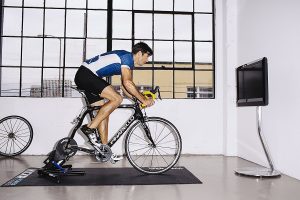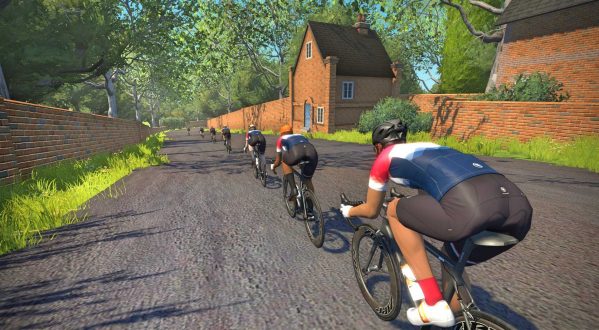Von Collins is an accomplished triathlete and endurance cyclist, and the author of four fitness and training books: Smarter Running, Your First Triathlon Guide, Fit Foods, and 30 Rut-Busting Workouts. He has been cited as a triathlon, cycling, and fitness expert by Healthline, CNET, Forbes, Eat This, Not That and other major outlets.
Winter arrives, or the weather is bad, or maybe you just don’t want to be cycling on the road during rush hour. There are many reasons we move our cycling indoors when fresh air, outdoors rides are usually preferable.
Indoor riding doesn’t have to be drudgery, though. In fact, in my experience, indoor cycling can provide some of the best, most intentional training of the year.
One of the biggest benefits of indoor cycling is that it is a low-impact workout for your joints, while being VERY productive for your heart and lungs, and it can burn lots of calories, too. My experience is that I often feel better after a good, hard indoor ride than a run or even some of my outdoor rides, because of the workout precision and the controlled environment.
A second huge benefit of indoor cycling is that it is efficient. You can get a very good workout in just 30 minutes. If you have an hour or more, even better. But you don’t need to ride and ride to get the work in — it can happen quickly!
Indoor Cycling Options
Fortunately, indoor cycling is not what it used to be a couple decades ago — it is 10 times better! There are several indoor cycling alternatives that you can try right from the comfort of your own home, or from a gym or studio if you have access to one. Below are some of my go-to indoor cycling alternatives:.
Home-Based Smart Trainer
A home-based smart trainer is a great option for those who want to bring the spin class experience to their home, and have the option of several different apps to choose from for the workouts. These trainers are designed to mimic the feel of outdoor cycling as much as possible and provide a challenging workout. With a smart trainer, you can connect to various training apps and ride with others from around the world. You can also see your power stats, customize your workouts and track your progress over time.
Pros:
- You can use your own bike
- The volume of cycling app options provides plenty of choices for workouts
Cons:
- Usually done in solitude
- Smart trainers cost several hundred dollars
Peloton or Other Connected Bike
 Peloton and other connected bikes like the Wattbike are becoming increasingly popular among cyclists. These bikes come with a large screen that displays live and on-demand classes, allowing you to feel like you are in a spin class from the comfort of your own home. You can also track your progress and compete with others on the leaderboard. While these bikes can be expensive, many feel they are worth it as they are a great investment for those who are serious about training regularly from the comforts of your own home.
Peloton and other connected bikes like the Wattbike are becoming increasingly popular among cyclists. These bikes come with a large screen that displays live and on-demand classes, allowing you to feel like you are in a spin class from the comfort of your own home. You can also track your progress and compete with others on the leaderboard. While these bikes can be expensive, many feel they are worth it as they are a great investment for those who are serious about training regularly from the comforts of your own home.
Pros:
- Built-for-purpose equipment and apps are highly-integrated
- Easy for multiple people to use the same piece of equipment
Cons:
- Vendor lock – you need to use that bike with their app, no other choices
Group Spin Class
 Many people get much better workouts if they are with other people. If you prefer the social aspect of spin class, then a group spin class may be the perfect option for you. Many gyms, studios, and fitness centers offer spin classes that are led by an instructor and set to upbeat music. These classes are a great way to get a good sweat, meet new people, and stay motivated. Plus, the instructor can help coach you with proper form and technique.
Many people get much better workouts if they are with other people. If you prefer the social aspect of spin class, then a group spin class may be the perfect option for you. Many gyms, studios, and fitness centers offer spin classes that are led by an instructor and set to upbeat music. These classes are a great way to get a good sweat, meet new people, and stay motivated. Plus, the instructor can help coach you with proper form and technique.
Pros:
- Energy from a live group setting is often unparalleled
- Find the right instructor, and the workout can be great
Cons:
- Requires going somewhere
- Some classes might be too easy or too hard for you
Old Fashioned Stationary Bike
If you are on a budget or prefer a simpler workout, an old-fashioned stationary bike may be your answer, but it should be the last resorts. While these bikes do not have all the bells and whistles of a smart trainer or connected bike, they can still provide a great workout provided you put in the effort. You can adjust the resistance to increase the intensity of your workout and track your progress over time. You can usually get used stationary bikes for little-to-nothing too, given they they are not as popular anymore.
Pros:
- Inexpensive
Cons:
- No benefits of smart, precision training
- Stationary bikes often have weird posture compared to real bikes
Best Types of Indoor Bike Workouts
High-Intensity Interval Training (HIIT)
HIIT is a term that applies to way more than just cycling, but incorporating it into cycling workouts can be so effective. It would involve an indoor cycling workout that involves short bursts of high-intensity exercise followed by periods of rest or low-intensity exercise, and at times even hopping off the bike for upper body or core work. This type of workout typically consists of 30-second to 1-minute intervals of high-intensity cycling, followed by 1-2 minutes of rest or low-intensity cycling. HIIT workouts are known for their ability to burn a high number of calories in a short period of time, improve cardiovascular health, and increase endurance, and add strength work in many cases. I feel great after any HIIT workout.
Best for: People who want a balanced workout in a short amount of time, and prefer to integrate some core or strength work into the workout
Endurance Rides
Indoor endurance rides are exactly what they sound like – long, steady-state workouts that focus on building endurance, burning fat stores, and improving cardiovascular health. This type of workout typically consists of cycling at a moderate intensity for an extended period of time, often an hour or more. Endurance rides are great for improving cardiovascular health, increasing endurance, and burning calories. For endurance rides, you want to keep your heart rate around Zone 2, never letting it get too high. For many adults is in the 120-135 bpm range and would be considered a low-to-moderate intensity workout.
Best for: Gradual fat-burning and base-building
Climbing Workouts
Climbing workouts are some of my favorites when I am short on time. They simulate hill climbs and are designed to improve leg strength and power. You can either do them with the simulated power and wattage of a climb, or if you are using Zwift you can actually choose a course that has one of Zwift’s good climbs in it.
This type of workout typically consists of cycling at a high resistance with a slower cadence to simulate climbing a steep hill. You will probably find yourself standing out of the saddle at times. It is common for the climbs to be anywhere from 2 to 6 minutes long with some rest in between. Climbing workouts are great for building leg strength, improving cardiovascular health, and burning calories.
Best for: Building up your VO2 max and increasing your training intensity
Speed or Sprint Intervals
Speed or sprint intervals are short bursts of high-intensity cycling designed to improve speed and power. This type of workout typically consists of 10-30 second intervals of all-out sprinting followed by periods of rest or low-intensity cycling. Sprinting workouts are best done on a smart trainer where you have a power readout, so you can keep yourself honest and be sure you are going all-out.
Best for: Quad work and high-heart rate work, where you will get your heart rate up to Zone 4 and 5 and a good leg burn
Threshold Work
Threshold work is a type of workout that focuses on improving lactate threshold, which is the point at which the body starts to produce more lactate than it can clear. This type of workout typically consists of cycling at a high intensity for an extended period of time, usually 20-30 minutes, or perhaps 8 to 10 minutes but then repeating after some rest. Threshold work is great for improving lactate threshold, increasing endurance, and burning calories. To do a good threshold set, you will need to do some benchmarking to know your functional threshold power (FTP), because your workout intensity should be based on that number.
Best for: A good staple workout, multiple times per week, as you prepare for your race or peak season. Ideal when you are in building phase of your training plan.
Training Programs and Apps
With the rise of technology and the internet, there are now many training programs and apps available to help you get the most out of your indoor cycling workouts.
Subscription-Based Platforms
One of the go-to ways to access a wide variety of indoor cycling workouts is through a subscription-based platform. These platforms typically offer a range of workouts, from beginner to advanced, and allow you to track your progress over time.
Some popular subscription-based platforms include:
- Peloton: Peloton offers live and on-demand classes, as well as a range of other fitness content. The platform also offers a range of equipment, including bikes and treadmills.
- Zwift: Zwift is a virtual cycling platform that allows you to ride with other cyclists from around the world. The platform offers a range of workouts and challenges to keep you motivated.
- TrainerRoad: TrainerRoad offers a range of structured workouts, as well as training plans to help you reach your fitness goals.
- SufferFest: Like TrainerRoad, but often with real video footage of actual courses.
When it comes to Zwift vs. Trainerroad vs. SufferFest, it is really a personal preference decision.
If you are old school, you can find some really good training DVDs from years past. I like the ones by Spinervals. However, you typically will not have the benefit of your workout being integrated with your actual power output, which is a main feature of today’s smart-trainer and app systems. This method can be good, however, if all you have available to you is a non-smart bike trainer or an old fashioned stationary bike.
Indoor Cycling Safety Tips and Best Practices
Hydration and Nutrition
You will sweat alot while doing indoor cycling — probably more than on your outdoor rides. I always make sure to hydrate before, during, and after my indoor cycling workouts. Drinking water before and during the workout helps me stay hydrated and maintain my energy levels. It’s also important to fuel your body with the right nutrients. This can also be a great time to test out the hydration and nutrition products you might want to use outdoors, but test them in a safe environment.
Posture and Form
Maintaining proper posture and form is crucial during indoor cycling workouts. The good news is that your form should be highly-controllable when cycling indoors. I make sure to adjust my bike to the appropriate height and distance from the handlebars to ensure proper alignment. I also focus on keeping my core engaged and my shoulders relaxed. It’s important to avoid leaning too far forward or backward, as this can put unnecessary strain on the back and neck. When in doubt, get a good professional bike fitting.
Injury Prevention
To prevent injuries during indoor cycling workouts, I always start with a proper warm-up and cool-down. In fact, any good workout on the popular cycling apps will include this naturally, and any spin instructor will too. This helps to increase blood flow and flexibility, which can reduce the risk of injury. I also make sure to listen to my body and adjust my workout as needed, especially in the early season. It’s important to avoid overexertion and take breaks when necessary, especially when doing those all-out workouts.
Should You Consider Riding Outside?
Don’t just assume that you have to ride indoors during winter. While indoor cycling workouts have their benefits, outdoor cycling can be done when many assume it cannot.

Winter Cycling Gear
One of the biggest challenges of outdoor cycling in the winter is staying warm. However, with the right gear, you can still enjoy a ride in the crisp winter air. Ifyou are in a snowy area, you will probably want a fat bike so that you don’t have to worry about wiping out on a slick surface, and to help you flat on the snow.
You will also need some different gear for winter riding. I would start with a good insulated cycling jacket, some knee warmers or leg warmers, a good pair of cycling gloves, and either a gaiter or balaclava for your face and neck.
Safety Considerations
If you do decide to ride outside during the offseason, be sure to take a few extra precautions like:
- Avoiding low-visibility hours, which is more difficult given the shorter days in winter
- Choose trails or roads that are safe and not putting you in precarious spots with traffic
- Using front and rear bike lights for visibility
- Dressing up enough so you don’t get frostbite or other cold-induced conditions







